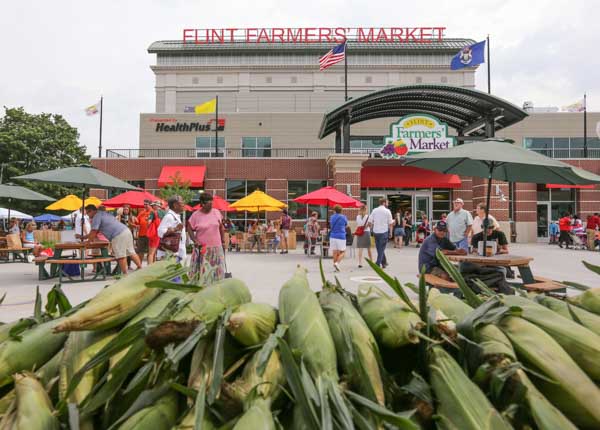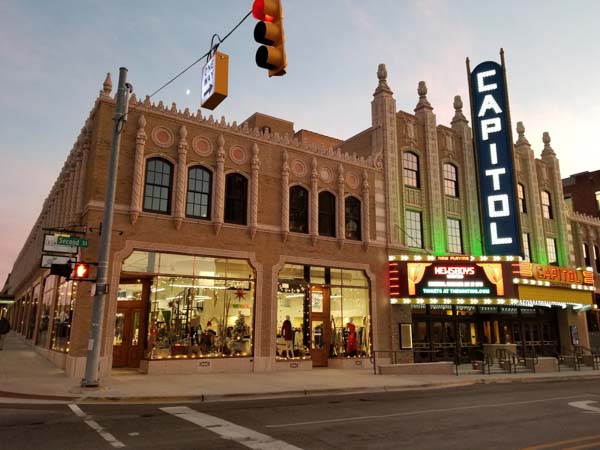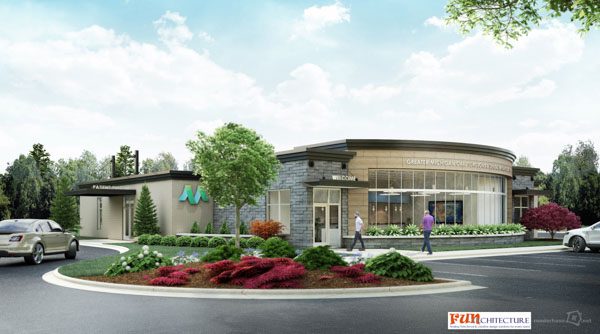By Amy Spooner
To be clear, a building’s aesthetic matters a great deal to Shannon Easter White, B.S. ’00, M.Arch ’03. Her firm’s name is FUNchitecture (pronounced funkitecture). Its tagline is work that makes you smile, and that work is award-winning.
But really, White sees herself as a problem solver.
“Architecture is about getting butts in seats at a concert hall; it’s about effectively and efficiently treating patients to drive down healthcare costs, and making somebody feel included and mindful in a place of worship. Beyond what a building looks like, architecture is about complex problem solving,” she says.
In her hometown of Flint, Michigan, and beyond, White has developed a reputation for doing just that.
Beyond the water crisis that put Flint in the international spotlight, Flint has seen tough times recently. One result is a dwindling tax base that makes funding scarce for renovations and new construction. So White has become savvy at leveraging tax credits and structuring finance deals to launch projects and move them forward.
“I get calls where the client says, ‘I’m contacting you because I know you know how to do this,’” she says.
One example is Northern Market, in the northwest Michigan town of Grayling. While the area is rich with farmers, they have few options for selling goods locally. Shipping them three hours south to Detroit’s Eastern Market is inefficient and creates a “dead leg” when empty trucks return. White worked with community leaders, farmers, and distributors to design the market, which will hopefully open in 2021 and is expected to become a local hub and a tourist destination. Besides its proximity to I-75, which brings tourists “up north,” the design boasts a variety of attractions beyond the farmers’ market vendors — including a play area; restaurants; and the opportunity to see USDA-certified production facilities for eggs, maple syrup, apple cider, and honey in action. In addition, Northern Market houses training facilities for food preparation and safety, farm and garden education, and other agricultural trades. Detroit-based Leonardo’s Produce will truck food to northern Michigan and return to Detroit, bringing northwest-Michigan products to sell at Eastern Market and returning with southern-Michigan-grown products not available in Grayling.


The Flint Farmers’ Market, designed by Shannon Easter White, B.S. ’00, M.Arch ’03, was voted one of the top five best public spaces as part of the American Association of Planners’ Great Places in America list.
“It took getting many minds together to think through problems like transportation, logistics, access to healthy food, and more that originated because people recognized Grayling needed a farmers’ market,” White says.
White’s leadership with a farmers’ market closer to home had put her on the radar for the folks in Grayling. She had a longstanding relationship with the Flint Farmers’ Market, so as the market outgrew its old space, they asked her to help them figure out what was next.
Since the Flint Farmers’ Market building was nearly 100 years old, expansion would require extensive renovation to bring it up to code. White, the market’s leadership, and the developers financing the deal saw the potential in relocating to a nearby warehouse that had been vacated by the defunct Flint Journal newspaper. Although the move would be less than a mile, it met public resistance. First, there was a great deal of nostalgia for the old space, and the move was seen as further evidence that Flint was losing its grip on its proud history.
Second, one of the leaders of Uptown Investment Corporation, which had assumed oversight of the market from the city, was White’s husband. Although the project was put out for bid and the market chose White (over her husband’s objections, White points out with a laugh), the alliance was controversial.
“We were lambasted at public meetings to the point where we had to take the microphone away sometimes,” White says.
Ultimately, the market moved, and when it opened in 2014, “the naysayers quit upon arrival,” White says. “They saw it was 200 percent better than the previous space. And vendors were happy because sales skyrocketed.”
Six years later, the year-round market is home to more than 50 vendors. A rooftop terrace allows people to enjoy the foods they just purchased. The market has hosted events ranging from weddings to chili cook-offs to the county-wide kindergarten roundup, where attendees munched on apples from a local orchard that is a market vendor. In 2015, the American Association of Planners voted it one of the top five best public spaces as part of its Great Places in America list.
“It was a great example of adaptive reuse,” White says of the market. “And it supports entrepreneurship because it offered space for new vendors. I’m proud that it has become a regional destination and a model for others nationwide.”

Flint’s historic Capitol Theatre houses White’s firm and retail boutique.
But White is not resting on her laurels. Her firm of two architects brings in about 40 million dollars’ worth of work annually. In 2017, on the heels of the highly touted renovation of downtown Flint’s historic Capitol Theatre to include office and retail space, White designed FUNchitecture’s new headquarters and a retail boutique called SHIFT that she launched with a friend. Other upcoming FUN projects include a new credit union headquarters in nearby Grand Blanc, an oral surgery office in neighboring Midland, and the adaptive reuse of a tire store into a restaurant in Okemos. She coyly admits to having a few other things up her sleeve, as well.
“I run at zero percent or 100 percent; there’s no speed in between,” White says.
That’s been her M.O. for a while. White began her undergraduate career at Western Michigan University in the honors college and playing collegiate soccer; she transferred to Michigan when she decided to switch from pre-med to architecture. When she returned to U-M as an M.Arch, White commuted daily between classes in Ann Arbor and a job in Flint at Tomblinson Harburn Associates (now THA Architects Engineers) — founded by James Tomblinson, B.Arch ’51, and Gerald Harburn, B.Arch ’54, M.Arch ’57. Years later, she launched FUNchitecture shortly after becoming a mother; her infant daughter sat alongside White during her final NCARB exam.
“The world needs little ol’ architects in every rural town and community because we have a responsibility to protect the health, safety, and welfare of the public.”
— Shannon Easter White, B.S. ’00, M.Arch ’03
The close timing of the births of her daughter and her firm is not a coincidence. While on maternity leave from Tomblinson Harburn in 2009, White wrestled with whether or not to return; when several clients called her at home, saying they only wanted to work with her, she realized she could hang her own shingle.
She credits the firm with giving her the experience and mentorship to do so. “Gerry was an amazing designer, and Jim was an amazing business man,” she says of Harburn and Tomblinson. “I learned both sides of running a firm from them.” From 2005 to 2010, she was director of business development, which taught her how to write a proposal, develop a fee structure, and “talk the lingo of an architect in a way that a client could understand.” As one of the youngest stockholders in the firm, it also taught her how to run a firm while having hard conversations during a global economic downturn.
The experience that White gained through a professional exchange program early in her career also has influenced her. During five weeks in Italy, she shadowed the architect restoring San Marco Basilica in Venice and an architect in a tiny town near the Slovenian border, which showed the importance of architects regardless of scale. Back at home in Flint, that lesson drives her approach.

White’s focus on energy efficiency led to low heating bills for one client, an oral surgery office, even during Michigan’s 2019 Polar Vortex.
“The world needs little ol’ architects in every rural town and community because we have a responsibility to protect the health, safety, and welfare of the public,” she says. In addition to her work with adaptive reuse, White is focused on energy efficiency. She is especially proud of the LEED Platinum certification she earned for the Urban Alternative House, a collaboration between the University of Michigan-Flint and the Genesee County Land Bank; she also notes that even during Michigan’s 2019 Polar Vortex, the heating bill for one of her clients, a surgery office, was less than $40 per month. She also has been heavily involved in the water crisis, as clients with new and previous projects grapple with lingering distrust of the water. “It has brought architects and the whole community together,” she says. “We’re intent on changing the narrative and showing people that seeing is believing with regard to Flint’s recovery.”
It all feeds into White’s “no-growth plan” for her career. The next hot building in a big metropolis is not her goal. “Flint is the birthplace of General Motors, where innovation met great design through great partnerships,” she says. “Flint deserves the best, so I strive for that every day.”





